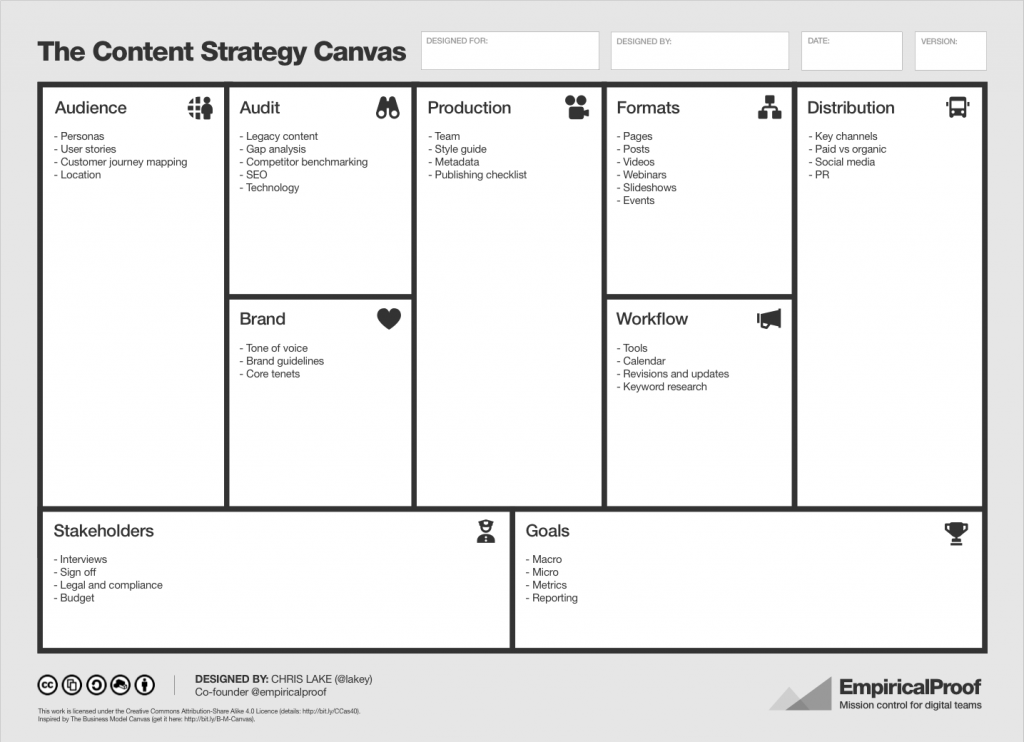A couple of years ago I created the Periodic Table of Content Marketing, to help people create the right kind of content for their brands.
That visualisation was very much tactical, in terms of its scope. I wanted to combine a brainstorming tool with a checklist, to help with the content creation process.
I purposefully allocated just one of the 132 ‘elements’ to content strategy… the first element, in fact. Why? Because content strategy requires a lot more focus and input from content teams and stakeholders. There are many questions to ask, and the answers given will differ from company to company.
As such, content strategy needs a different approach, and one that is less prescriptive. I’ve come up with the Content Strategy Canvas, as a loose structure for figuring out where you’re at, and where you want to be. I hope it proves useful.
Click on the images below to see a large, hi-res, printable version (by all means download, use, and share around).

By way of a brief explanation, I’ve been recently mapping out the broader business strategy for EmpiricalProof. Last Friday we ran a value proposition design workshop based around the process outlined in the (excellent) Strategyzer book. The workshop involved a lot of Post-It notes, and was based around customer research. We all found it really useful.
Value proposition design covers a couple of key areas in the Business Model Canvas, which I’m sure you’re already aware of. It is, of course, the visual framework for my Content Strategy Canvas (I doff my hat!).
The Content Strategy Canvas doesn’t exactly mirror the Business Model Canvas, but it could certainly be used to run a practical workshop along similar lines.
Let me give you a quick rundown of the things it covers. These are the nine areas that every content team needs to think about…
Audience
Who are you targeting, and why?
What makes them tick?
Where do they live, and when are they most active?
Audit
What have you already got going on?
Where are the gaps?
What’s working well for your competitors?
Brand
What are your brand guidelines?
What should you definitely not do?
What tone of voice do you use?
Production
Who is in your team, and what do they do?
Where does the style guide live?
Do you have a pre-publishing checklist?
Formats
Which content formats will you be using?
What do you need to start creating content?
Workflow
What tools will you be using?
Have you produced a content calendar?
How will you manage your evergreen content?
Distribution
Where will you distribute your content?
Are you going to do any paid promotion?
Can your PR team help?
Stakeholders
What does your boss expect you to do?
Who will be involved in the sign off process?
Goals
What are the main goals for your content?
How will you measure success?
Who needs to see the stats?
Sample
Below is a visual summary of some of these points. These are just a few jumping off points for you… it’s best to run a practical workshop. Get into the detail and be specific. For example, in ‘Distribution’ you should list the various channels you will use to drum up interest in your content, and the main tactics you’ll employ to generate awareness.

Although I’ve put goals at the bottom right, that’s always, always, always the place to start. The content teams I’ve run in the past have always been tuned into the primary business goals, as well as the secondary tactical goals. Make sure everybody understands why Team Content exists.
It’s also good idea to run a regular content strategy workshop, to sense check what you’re doing. Regardless of whether you’re starting from scratch or doing an audit for an established brand, you should think about Stakeholders and Goals first. Everything else flows from there. Avoid this and you run the risk of producing aimless content.
That’s the long and short of it. I hope it comes in handy.
Do let me know what you think in the comments area below, or just get in touch if you want any specific pointers.

